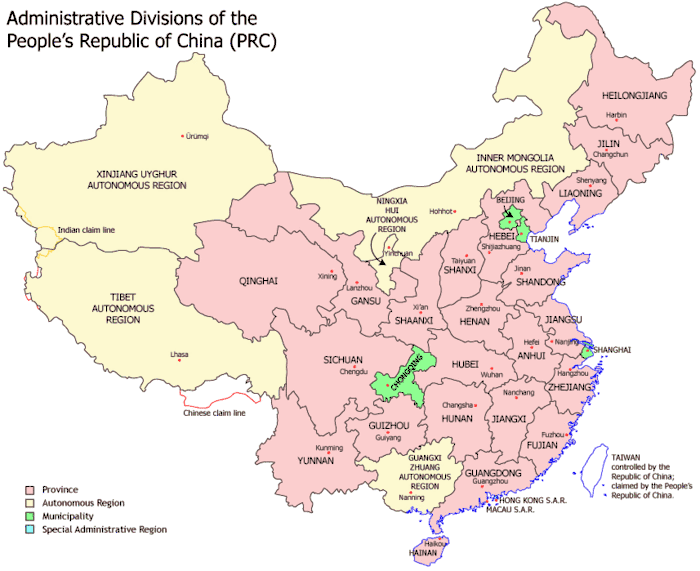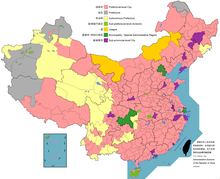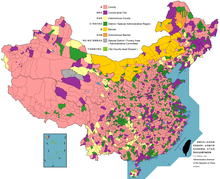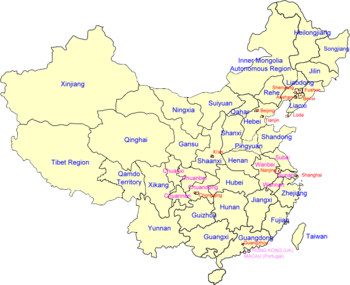Administrative divisions of China
| This article is part of a series on |
| Administrative divisions of China |
|---|
|
Analogous county level units Management areas Management committee |
|
Townships
Subdistricts County-controlled districts (pilot) |
|
Analogous township level units Management areas Management committee Areas Farms area, Prison area, University towns etc. |
|
|
|
History: before 1912, 1912–49, 1949–present Administrative division codes |
Due to China's large population and area, the administrative divisions of China have consisted of several levels since ancient times. The constitution of China provides for three de jure levels of government. Currently, however, there are five practical (de facto) levels of local government: the provincial (province, autonomous region, municipality, and special administrative region), prefecture, county, township, and village.
Since the 17th century, provincial boundaries in China have remained largely static. Major changes since then have been the reorganization of provinces in the northeast after the establishment of the People's Republic of China and the formation of autonomous regions, based on Soviet ethnic policies. The provinces serve an important cultural role in China, as people tend to identify with their native province.
Levels
The Constitution of China provides for three levels: the provincial (province, autonomous region, municipality, and special administrative region), county, and township. However, two more levels have been inserted in actual implementation: the prefecture, under provinces; and the village, under townships. There is a sixth level, the district public office, below counties, but it is being abolished. As of 2017, China administers 33 provincial-level regions, 334 prefecture-level divisions, 2,862 county-level divisions, 41,034 township-level administrations, and 704,382 village-level subdivisions.[1]
Each of the levels (except "special administrative regions") correspond to a level in the Civil service of the People's Republic of China.
Table
Summary
This table summarizes the divisions of the area administered by the People's Republic of China As of June 2017.
| Level | Name | Types |
|---|---|---|
| 1 | Provincial level (1st) 省级行政区/ 一级行政区 (33) (1 claimed) |
|
| 2 | Prefectural level (2nd) 地级行政区/ 二级行政区 (334) |
|
| 3 | County level (3rd) 县级行政区/ 三级行政区 (2,851) |
|
| 4 | Township level (4th) 乡级行政区/ 四级行政区 (39,864) |
|
| 5 | Village level (5th) 村级行政区/ 五级行政区 (662,393) informal |
|
Provincial level (1st)
The People's Republic of China (PRC) administers 34 provincial-level divisions (省级行政区) or first-level divisions (国家地方一级行政区域), including 23 provinces, five autonomous regions, four municipalities, and two special administrative regions:
Provinces are theoretically subservient to the PRC central government, but in practice provincial officials have large discretion with regard to economic policy. Unlike the United States, the power of the central government was (with the exception of the military) not exercised through a parallel set of institutions until the early 1990s. The actual practical power of the provinces has created what some economists call federalism with Chinese characteristics.
Most of the provinces, with the exception of the provinces in the northeast, have boundaries which were established long ago in the Yuan, Ming, and Qing dynasties. Sometimes provincial borders form cultural or geographical boundaries. This was an attempt by the imperial government to discourage separatism and warlordism through a divide and rule policy. Nevertheless, provinces have come to serve an important cultural role in China. People tend to be identified in terms of their native provinces, and each province has a stereotype that corresponds to their inhabitants.
The most recent administrative changes have included the elevation of Hainan (1988) and Chongqing (1997) to provincial level status, and the creation of Hong Kong (1997) and Macau (1999) as Special administrative regions.
Provincial level governments vary in details of organization:
 |
| First or provincial level Administrative divisions of China by: |
|---|
Provincial-level (1st) subdivisions
| 22 Provinces (省; shěng): A standard provincial government is nominally led by a provincial committee, headed by a secretary. The committee secretary is first-in-charge of the province, come in second is the governor of the provincial government. | |
| 5 Autonomous regions (自治区; zìzhìqū): A minority subject which has a higher population of a particular minority ethnic group along with its own local government, but an autonomous region theoretically has more legislative rights than in actual practice. The governor of the Autonomous Regions is usually appointed from the respective minority ethnic group. | |
| 4 Municipalities (直辖市; zhíxiáshì): A higher level of city that is directly under the Chinese government, with status equal to that of the provinces. In practice, their political status is higher than that of common provinces. | |
| 2 Special administrative regions (SARs) (特别行政区;tèbié xíngzhèngqū): A highly autonomous and self-governing subnational subject of the People's Republic of China. Each SAR has a chief executive as head of the region and head of government. The SAR's government is not fully independent, as foreign policy and military defence are the responsibility of the central government, according to the Basic Laws of the two SARs.[5][6][7] | |
| 1 Claimed province: The People's Republic of China claims the island of Taiwan and its surrounding islets, including Penghu, as "Taiwan Province". (Kinmen and the Matsu Islands are claimed by the PRC as part of its Fujian Province. Pratas and Itu Aba are claimed by the PRC as part of Guangdong and Hainan provinces respectively.) The territory is controlled by the Republic of China (ROC, commonly called "Taiwan"). |


Prefectural level (2nd)

Prefectural level divisions or second-level divisions are the second level of the administrative structure. Most provinces are divided into only prefecture-level cities and contain no other second level administrative units. Of the 22 provinces and 5 autonomous regions, only 3 provinces (Yunnan, Guizhou, Qinghai) and 2 autonomous regions (Xinjiang, Tibet) have more than three second level or prefectural level divisions that are not prefecture-level cities. As of 18, August 2015, there were 334 prefectural level divisions:
| 7 Prefectures (地区; dìqū): formerly the dominant second level division, thus this administrative level is often called "prefectural level". They were mostly replaced by prefecture-level cities from 1983 to the 1990s. Today, prefectures exist only in Heilongjiang, Tibet and Xinjiang. |
| 30 Autonomous prefectures (自治州; zìzhìzhōu): prefectures with one or more designated ethnic minorities, mostly in China's western regions. |
| 294 Prefecture-level cities (地级市; dìjíshì): the largest number of prefectural-level divisions, generally composed of an urban center and surrounding rural areas much larger than the urban core and thus not "cities" but municipalities in the strict sense of the term |
| 3 Leagues (盟; méng): effectively the same as prefectures, but found only in Inner Mongolia. Like prefectures, leagues have mostly been replaced with prefecture-level cities. The unique name is a holdover from earlier forms of administration in Mongolia. |
County level (3rd)

As of August 18, 2015, there were 2,852 county-level divisions:
| 1,408 Counties (县; xiàn): the most common county-level divisions, continuously in existence since the Warring States period, much earlier than any other level of government in China. Xian is often translated as "district" or "prefecture". |
| 117 Autonomous counties (自治县; zìzhìxiàn): counties with one or more designated ethnic minorities, analogous to autonomous regions and prefectures |
| 360 County-level cities (县级市; xiànjíshì): similar to prefecture-level cities, covering both urban and rural areas. It was popular for counties to become county-level cities in the 1990s, though this has since been halted. |
| 913 Districts (市辖区; shìxiáqū): formerly the subdivisions of urban areas, consisting of built-up areas only. Recently many counties have become districts, so that districts are now often just like counties, with towns, villages, and farmland. |
| 49 Banners (旗; qí): the same as counties except in the name, a holdover from earlier forms of administration in Mongolia |
| 3 Autonomous banners (自治旗; zìzhìqí): the same as autonomous counties except in the name, a holdover from earlier forms of administration in Mongolia |
| 1 Forestry area (林区; línqū): a special county-level forestry district located in Hubei province |
| 1 Special district (特区; tèqū): a special county-level division located in Guizhou province |
Township level (4th)
Township-level (4th) subdivisions
| 13,749 Townships (乡; xiāng): in smaller rural areas division they are divided into this subject |
| 1,098 Ethnic townships (民族乡; mínzúxiāng): small rural areas divisions designated for one or more ethnic minorities are divided into this subject |
| 19,322 Towns (镇; zhèn): in larger rural areas division they are divided into this subject |
| 6,686 Subdistricts (Subdistrict offices) (街道办事处; jiēdào bànshìchù): in a small urban areas division they are divided into this subject |
| 2 District public offices (区公所; qūgōngsuǒ) are a vestigial level of government. These once represented an extra level of government between the county- and township-levels. Today there are very few of these remaining and they are gradually being phased out. |
| 181 Sumus (苏木; sūmù) are the same as townships, but are unique to Inner Mongolia. |
| 1 Ethnic sumu (民族苏木; mínzúsūmù) are the same as ethnic townships, but are unique to Inner Mongolia. |
| Numerous Economic and Technological Development Zones, Management Areas, Management Committees, Areas, Forestry Areas (林场), Farm Areas (农场, 原种场, 茶场, 养殖场, etc.), Prison Areas, University Towns, Administrative Districts (管理区), Fishery Area (渔场), etc. |
Village level (5th)
The village level serves as an organizational division (census, mail system) and does not have much importance in political representative power. Basic local divisions like neighborhoods and communities are not informal like in America, but have defined boundaries and designated heads (one per area):
In urban areas, every subdistrict of a district of a city administers many communities or neighborhoods. Each of them have a neighborhood committee to administer the dwellers of that neighborhood or community. Rural areas are organized into village committees or villager groups. A "village" in this case can either be a natural village, one that spontaneously and naturally exists, or an administrative village, which is a bureaucratic entity.
Village-level (5th) subdivisions
| 80,717 Neighborhood / Community committees (居民委员会; jūmínwěiyuánhuì) Neighborhood/Community groups (居民小组; jūmínxiǎozǔ) |
| Neighborhoods / Communities (社区; shèqū) |
| 623,669 Village committees (村民委员会; cūnmínwěiyuánhuì) Village groups (村民小组; cūnmínxiǎozǔ) |
| Villages (村; xíngzhèngcūn) |
| Gaqas (嘎查; gāchá) |
Group level (6th)
The village-level divisions of China are further divided into groups.
Group-level (6th) subdivisions
| Neighborhood/Community groups (居民小组; jūmínxiǎozǔ) |
| Village groups (村民小组; cūnmínxiǎozǔ) |
Special cases
Five cities formally on prefectural level have a special status in regard to planning and budget. They are separately listed in the five-year and annual state plans on the same level as provinces and national ministries, making them economically independent of their provincial government. These cities specifically designated in the state plan (Chinese: 计划单列市) are
In terms of budget authority, their governments have the de facto status of a province, but their legislative organs (National People's Congress and Chinese People's Political Consultative Conference) and other authorities not related to the economy are on the level of a prefecture and under leadership of the province.[8][9]
Some other large prefecture-level cities, known as sub-provincial cities, are half a level below a province. The mayors of these cities have the same rank as a vice governor of a province, and their district governments are half a rank higher than those of normal districts. The capitals of some provinces (seat of provincial government) are sub-provincial cities. In addition to the five cities specifically designated in the state plan, sub-provincial cities are[10]
- Harbin (Heilongjiang)
- Changchun (Jilin)
- Shenyang (Liaoning)
- Jinan (Shandong)
- Nanjing (Jiangsu)
- Hangzhou (Zhejiang)
- Guangzhou (Guangdong)
- Wuhan (Hubei)
- Chengdu (Sichuan)
- Xi'an (Shaanxi)
A similar case exists with some county-level cities. Some county-level cities are given more autonomy. These cities are known as sub-prefecture-level cities, meaning that they are given a level of power higher than a county, but still lower than a prefecture. Such cities are also half a level higher than what they would normally be. Sub-prefecture-level cities are often not put into any prefecture (i.e. they are directly administered by their province). Examples of sub-prefecture-level cities include Jiyuan (Henan province), Xiantao, Qianjiang and Tianmen (Hubei), Golmud (Qinghai), Manzhouli (Inner Mongolia), Shihanza, Tumushuk, Aral, and Wujiaqu (Xinjiang).
Some districts are also placed at half a level higher that what it should be. Examples are Pudong, Shanghai and Binhai, Tianjin. Although its status as a district of a municipality would define it as prefecture-level, the district head of Pudong is given sub-provincial powers. In other words, it is half a level higher than what it would normally be.
Special cases subdivisions
| 1 Sub-provincial autonomous prefecture (副省级自治州; fùshěngjízìzhìzhōu) |
| 15 Sub-provincial cities (副省级城市; fùshěngjíchéngshì) |
| 2 Sub-provincial new areas (副省级市辖新区; fùshěngjíchéngshìxiáqū) |
| 8 Sub-prefecture-level cities (副地级市; fùdìjíshì) |
Ambiguity of the word "city" in China
The Chinese word "市" (shì) is usually loosely translated into English as "city". However, it really has several different meanings due to the complexity of the administrative divisions used in China.
(Despite being urban or having urban centers, the SARs are almost never referred as "Hong Kong City"/"Macau City" in contemporary Chinese, thus excluded from below)
By its political level, when a "city" is referred to, it can be a:
- LV 1 (provincial-level):
- Municipality of China, for example, Chongqing
- LV 2 (prefecture-level):
- Sub-provincial city, for example, Shenzhen in Guangdong Province
- Prefecture-level city, for example, Shijiazhuang, capital of Hebei Province
- LV 3 (county-level):
- Sub-prefecture-level city, for example, Jiyuan (directly under the administration of Henan Province)
- County-level city, for example, Yiwu (under the administration of the prefecture-level city of Jinhua)
By its actual area and population, it can be:
- Province-like, which is the municipality of Chongqing, a merger of 4 former prefectures and similar to the former Eastern-Sichuan province
- Prefecture-like, which are the other three municipalities and almost all prefectural-level cities, usually 10-1,000 times larger than the urban center and a conglomeration of several counties and county-level cities. Some of them in sparsely populated areas like Hulunbuir are even larger than Chongqing but have a population comparable to that of prefectures.
- County-like, which is all sub-prefecture-level and some county-level cities, and several extremely simple prefecture-level cities (Jiayuguan, Xiamen, Haikou, etc.)
- Not substantially larger than urban establishment: some county-level cities, plus some members of the previous category. However, country-level cities converted from counties is unlikely to belong here. Shanghai, despite being prefecture-like in size, belongs here due to its subway already extending beyond municipality limits. Some other economically prosperous prefecture-level cities are also provoking inter-prefecture urban integration, although they still possess (and never intend to eliminate) large swaths of rural area.
When used in the statistical data, the word "city" may have three different meanings:
- The area administrated by the city. For the municipality, the sub-provincial city, or the prefecture-level city, a "city" in this sense includes all of the counties, county-level cities, and city districts that the city governs. For the Sub-prefecture-level city or the County-level city, it includes all of the subdistricts, towns and townships that it has.
- The area comprising its urban city districts and suburb city districts. The difference between the urban district and the suburb districts is that an urban district comprises only the subdistricts, while a suburb district also has towns and townships to govern rural areas. In some sense, this definition is approximately the metropolitan area. This definition is not applied to the sub-prefecture-level city and the county-level city since they do not have city districts under them.
- Somewhat bizarrely, some districts such as Haidian District also possess towns. They have been treated clearly as urban districts for decades, but not from the inception, and indeed some areas rural but other areas form an inseparable part of the central city.
- The urban area. Sometimes the urban area is referred as (Chinese: 市区; pinyin: shìqū). For the municipality, the sub-provincial city, and the prefecture-level city, it comprises the urban city district and the adjacent subdistricts of the suburb city districts. For the sub-prefecture-level city and the county-level city, only central subdistricts are included. This definition is close to the strict meaning of "city" in western countries.
It is important to specify the definition of "city" when referring to statistical data of Chinese cities, otherwise, confusion may arise. For example, Shanghai is the largest city in China by population in the urban area but is smaller than Chongqing by the population within the administration area.[11]
History

Before the establishment of the Qin Dynasty, China was ruled by a network of kings, nobles, and tribes. The rivalry of these groups culminated in the Warring States period, and the state of Qin eventually emerged dominant.
The Qin Dynasty was determined not to allow China to fall back into disunity, and therefore designed the first hierarchical administrative divisions in China, based on two levels: jùn commanderies and xiàn counties. The Han Dynasty that came immediately after added zhōu (usually translated as "provinces") as a third level on top, forming a three-tier structure.
The Sui Dynasty and Tang Dynasty abolished commanderies, and added circuits (dào, later lù under the Song and Jin) on top, maintaining a three-tier system that lasted through the 13th Century. (As a second-level division, zhou are translated as "prefectures".) The Mongol-established Yuan Dynasty introduced the modern precursors to provinces, bringing the number of levels to four. This system was then kept more or less intact until the Qing Dynasty, the last imperial dynasty to rule China.
The Republic of China streamlined the levels to just provinces and counties in 1928, and made the first attempt to extend political administration beyond the county level by establishing townships below counties. This was also the system officially adopted by the People's Republic of China in 1949, which defined the administrative divisions of China as three levels: provinces, counties, and townships.
In practice, however, more levels were inserted. The ROC government soon learned that it was not feasible for a province to directly govern tens and sometimes hundreds of counties. Started from Jiangxi province in 1935, Prefectures were later inserted between provinces and counties. They continue be ubiquitously applied by the PRC government to nearly all areas of China until the 1980s. Since then, most of the prefectures were converted into prefecture-level cities. Greater administrative areas were inserted on top of provinces by the PRC government, but they were soon abolished, in 1954. District public offices were inserted between counties and townships; once ubiquitous as well, they are currently being abolished, and very few remain.
The most recent major developments have been the establishment of Chongqing as a municipality and the creation of Hong Kong and Macau as special administrative regions.
Reform
In recent years there have been calls to reform the administrative divisions and levels of China. Rumours of an impending major reform have also spread through various online bulletin boards.[12]
The district public offices is an ongoing reform to remove an extra level of administration from between the county and township levels. There have also been calls to abolish the prefecture level, and some provinces have transferred some of the power prefectures currently hold to the counties they govern. There are also calls to reduce the size of the provinces. The ultimate goal is to reduce the different administration levels from five to three (Provincial level, County level, Village level), reducing the amount of corruption as well as the number of government workers, in order to lower the budget.
See also
References
- ↑ 中国的行政区划——省级行政单位
- ↑ "街道 jiēdào (名)1 street 2 what concerns the neighborhood: ~ 办事处 subdistrict office. {...}" 精选汉英词典(第四版). Concise Chinese-English Dictionary (Fourth Edition). 牛津大学出版社与商务印书舘. Oxford University Press and The Commercial Press. 2011. p. 248.
- ↑ "【街道办事处】 jiēdào bànshìchù 市辖区、不设区的市的人民政府派出机关。 在上一级政府领导下,负责本辖区内的社区服务、经济发展、社会治安等工作。" 現代漢語詞典(第七版). Contemporary Chinese Dictionary (Seventh Edition). 商務印書舘. The Commercial Press. 1 September 2016. p. 663. ISBN 978-7-100-12450-8.
- ↑ Administrative divisions of the People's Republic of China (中华人民共和国行政区划; Zhōnghuá Rénmín Gònghéguó Xíngzhèng Qūhuà), 15 June 2005, retrieved 5 June 2010
- ↑ Chapter II : Relationship between the Central Authorities and the Hong Kong Special Administrative Region, Article 12, retrieved 5 June 2010
- ↑ Chapter II Relationship between the Central Authorities and the Macau Special Administrative Region, Article 12, archived from the original on 5 February 2012, retrieved 5 June 2010
- ↑ "Baidu Baike" (in Chinese).
- ↑ "Hudong Wiki" (in Chinese).
- ↑ "Baidu Baike" (in Chinese).
- ↑ Chan, Kam Wing (2007). "Misconceptions and Complexities in the Study of China's Cities: Definitions, Statistics, and Implications" (PDF). Eurasian Geography and Economics. University of Washington.
- ↑ Consulte-General of the People's Republic of China in New York: 民政部官员:“中国将要设50个省区市”报道失实 Archived 2009-09-23 at the Wayback Machine.
External links
| Wikimedia Commons has media related to Subdivisions of China. |
.svg.png)